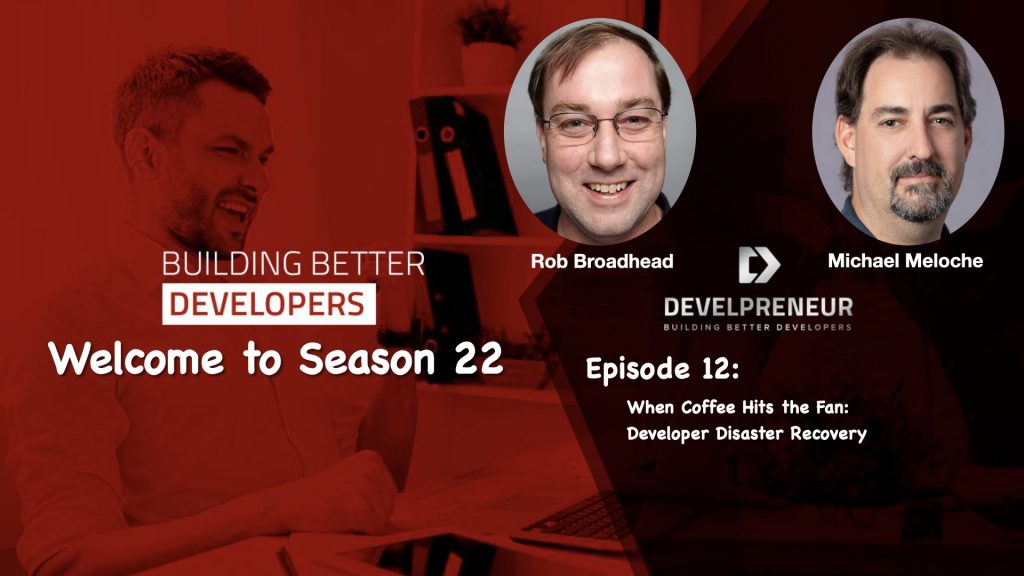Welcome back to our podcast as we continue our season on the developer journey. Today, we’re diving into a topic that resonates with many: navigating challenging work environments, or as we put it, “when the coffee hits the fan.” Specifically, we’ll discuss developer disaster recovery and how to manage such situations effectively.
Unforeseen Company Disasters
Recently, many companies experienced significant disruptions due to issues with system updates. These problems rendered many systems non-functional, highlighting the importance of preparedness in developer disaster recovery. As developers, we must anticipate and equip ourselves to handle such challenges.
Being a Prepared Road Warrior
In previous discussions, we’ve emphasized the importance of being a “road warrior” developer—prepared for work anywhere, anytime. Essential tools for developer disaster recovery include a versatile laptop with solid battery life, an array of adapters and chargers, and a reliable internet connection. However, preparedness goes beyond hardware.
Local and Cloud Solutions for Developers
One crucial aspect of developer disaster recovery is maintaining access to your work, regardless of connectivity or power issues. This can be achieved by keeping a local copy of your primary source code on an external drive. For those using distributed version control systems like GitHub, ensure you sync your repositories locally. This allows you to continue development even when offline, committing changes and creating branches to sync later.
Rob’s Real-life Example: Power Outage and Developer Disaster Recovery
Rob shares a personal story that underscores the importance of developer disaster recovery. About 15 years ago, while working in an office building, we experienced a complete power outage. Although we had laptops with decent battery life, we lost internet connectivity. Our manager ingeniously used his iPhone as a hotspot, allowing us to connect and continue working. This experience taught us the value of having contingency plans, such as mobile hotspots, for unexpected situations.
Michael’s Perspective: Agnostic Environments and Developer Disaster Recovery
Michael brings invaluable insights on creating environment-agnostic setups to mitigate risks associated with updates and system failures. Whether it’s an update to the IDE or operating system, such disruptions can cripple your workflow. Michael emphasizes the need for a resilient development setup, sharing an example from his early career where he used Citrix and VMs to create a stable and reliable environment. This approach ensured minimal downtime and maintained productivity even during hardware failures.
Cloud-based Solutions
In today’s world, cloud-based solutions offer even greater flexibility for developer disaster recovery. For instance, platforms like Amazon’s Cloud9 provide virtual development environments that are accessible from anywhere. This means you’re not tied to a specific machine, and as long as you have internet access, you can continue working seamlessly.
Using Cloud Storage and Version Control in Developer Disaster Recovery
Additionally, tools like Dropbox and personal cloud storage solutions ensure your files are always accessible. Using version control systems like GitHub is also crucial for developer disaster recovery. These tools not only keep your code safe but also allow for easy collaboration and version management.
Final Thoughts: Testing and Virtualization for Effective Developer Disaster Recovery
Michael wraps up with advice on the importance of testing in virtual environments. Before pushing updates or deploying new software, test in a controlled environment to ensure stability. Virtualization makes this process easier and cost-effective, allowing you to simulate real-world conditions and avoid potential pitfalls.
Ensuring Resilience in Developer Disaster Recovery
Being a developer means being prepared for the unexpected. By leveraging local and cloud solutions, setting up virtual environments, and maintaining a robust disaster recovery plan, you can confidently navigate even the most challenging environments. Stay ahead by anticipating potential disruptions and ensuring your tools and systems are ready to handle them.
Stay Connected: Join the Developreneur Community
We invite you to join our community and share your coding journey with us. Whether you’re a seasoned developer or just starting, there’s always room to learn and grow together. Contact us at [email protected] with your questions, feedback, or suggestions for future episodes. Together, let’s continue exploring the exciting world of software development.

